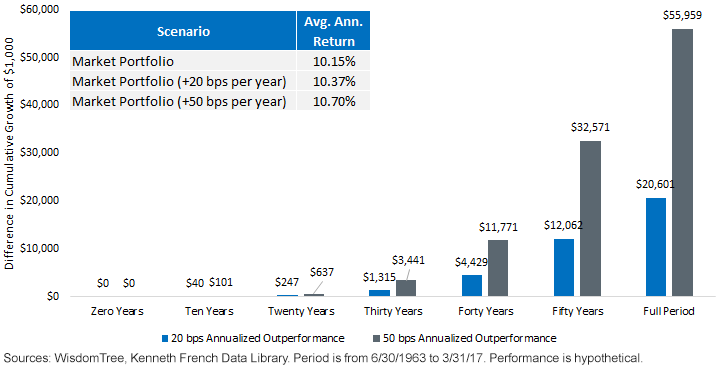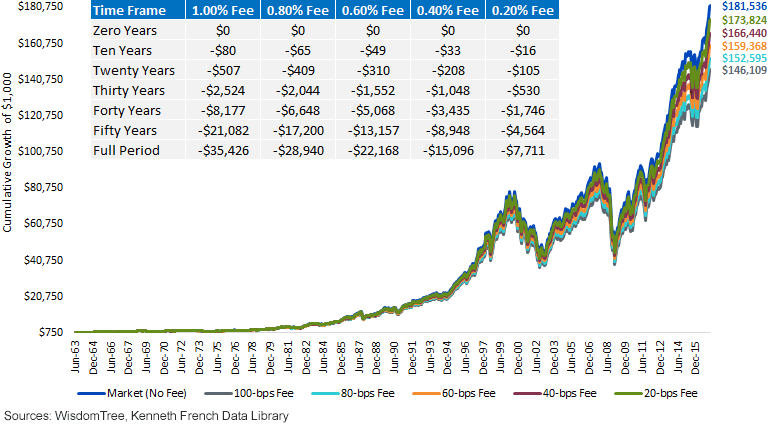Basis Points Matter, Especially over the Long Term


At WisdomTree, we are fortunate to have a rich tapestry of investment strategies with 10 years or more of live performance history. When looking at our U.S. Earnings Indexes, we find the following:1
- Broad Based: The WisdomTree Earnings Index outperformed the Russell 3000 Index, 7.77% to 7.40%, 33 basis points (bps) per year since inception.
- Large Cap: The WisdomTree Earnings 500 Index outperformed the S&P 500 Index, 7.50% to 7.34%, 16 bps per year since inception.
- Mid-Cap: The WisdomTree MidCap Earnings Index outperformed the S&P MidCap 400 Index, 9.74% to 9.05%, 69 bps per year since inception.
- Small Cap: The WisdomTree SmallCap Earnings Index outperformed the Russell 2000 Index, 8.56% to 7.09%, 147 bps per year since inception.
The issue: Particularly in the broad market and large-cap areas, clients tend to tell us that the margin of outperformance over this long period isn’t large enough to be “exciting” or at least enough of a catalyst to think about diverging from looking at market capitalization-weighted “beta” indexes.
How Important Is 20 Basis Points?
To put a round number to it, we took a step back and did the math to determine how much of a real difference 20 basis points of incremental, annualized outperformance actually is. We also looked at a 50-bps annualized outperformance.
Incremental Difference in Growth of Hypothetical $1,000 over Specified Periods (June 30, 1963, to March 31, 2017)

- The analysis starts with the market portfolio, which includes all U.S.-listed equities, market capitalization weighted. We then took the monthly returns and increased them in the appropriate fashion in order to equate to approximately 0.20%, or 0.50% per year. Due to compounding over a period greater than 50 years, the actual percentages weren’t EXACTLY 0.20% and 0.50% (rather, about 0.22% and 0.55%).
- If we recognize that with the assumption of only a hypothetical $1,000 going in and nothing further being contributed, at the 10-year mark, yes, there is a difference compared to the market, but one cannot say it’s a huge difference. The way compounding works—and what makes investing so hard in our society of instant gratification—is that the picture doesn’t start to get exciting until 30 to 50 years. But the point here is that it gets REALLY exciting. Over a 50-year period, an approximate outperformance over the market return of 20 bps led to more than $12,000, hypothetically. This figure was more than $32,500 at the 50-bps level.
While many people aren’t necessarily buying their investments with a 50-year holding period in mind, we do know that a popular term these days is “goals-based investing.” With increased life expectancies, even if people aren’t thinking 50 years ahead in their portfolios, there are certainly people out there with goals referring to 50 years into the future. Although 20 bps may not seem like much this year, next year or even next decade, over a goals-based horizon of multiple decades, it’s possible that it will add up.
The Market Immensely Values EVERY Basis Point
While it is absolutely true that we speak each day to investors who may not even raise their eyebrows at 10, 20 or 30 bps of annualized outperformance, we know that the collective U.S. market of investors absolutely cares—A LOT—about every single basis point. Otherwise, why would we be talking about “fee wars” or replacing human-led investment teams with algorithmic approaches? It’s a classic illustration of “framing.”
- Scenario 1: There is a portfolio with the potential to generate 10–30 bps of incremental outperformance over time with a rules-based investment process and a decade-plus track record.
- Scenario 2: There is a portfolio that just saw 10–30 bps of incremental fee reduction.
The current environment seems much more apt to respond to Scenario 2 than Scenario 1.
Cumulative Growth of Hypothetical $1,000 under Different Fee Scenarios (June 30, 1963, to March 31 2017)

- We start out by assuming again that there is a market portfolio holding all publicly listed U.S. equities. A hypothetical $1,000 in this portfolio from June 30, 1963, to March 31, 2017, would have grown to more than $181,500.
- If an investor were paying an annual fee of 1.00%, instead of getting to the $181,536 level, that investor would have gotten to a level of only approximately $146,109 (a $35,427 difference). If the annual fee were instead 0.20%, this difference would have been only $7,712, and the hypothetical growth would have gotten all the way to $173,824. So the difference between the 1.00% fee and the 0.20% fee is about $27,700 over this period.
- Similar to what we saw earlier, the benefit of lowering fees is not over the short term but rather over the long term. The difference over the first 10 years, for instance, was not all that great.
Passive vs. Active vs. Rules Based
So a big debate in today’s market regards whether it makes sense to be “active” or “passive.” In our opinion, any basis points that an investor can get from either outperformance or lower costs absolutely matter over the long run. This is why WisdomTree developed a suite of low-cost2 index-based investing options that we believe have potential to add to performance while mitigating costs.
1Source: Bloomberg, for period from 2/1/07 to 3/31/17.
2Ordinary brokerage commissions apply.

Christopher Gannatti began at WisdomTree as a Research Analyst in December 2010, working directly with Jeremy Schwartz, CFA®, Director of Research. In January of 2014, he was promoted to Associate Director of Research where he was responsible to lead different groups of analysts and strategists within the broader Research team at WisdomTree. In February of 2018, Christopher was promoted to Head of Research, Europe, where he was based out of WisdomTree’s London office and was responsible for the full WisdomTree research effort within the European market, as well as supporting the UCITs platform globally. In November 2021, Christopher was promoted to Global Head of Research, now responsible for numerous communications on investment strategy globally, particularly in the thematic equity space. Christopher came to WisdomTree from Lord Abbett, where he worked for four and a half years as a Regional Consultant. He received his MBA in Quantitative Finance, Accounting, and Economics from NYU’s Stern School of Business in 2010, and he received his bachelor’s degree from Colgate University in Economics in 2006. Christopher is a holder of the Chartered Financial Analyst Designation.

